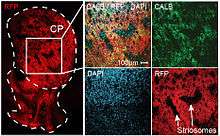Striosome
| Striosome | |
|---|---|
| Identifiers | |
| NeuroLex ID | Striosome |
The striosomes (also referred to as the striatal patches) are one of two complementary chemical compartments within the striatum (the other compartment is known as the matrix) that can be visualized by staining for immunocytochemical markers such as acetylcholinesterase,[1] enkephalin, substance P, limbic system-associated membrane protein (LAMP),[2] AMPA receptor subunit 1 (GluR1),[3] dopamine receptor subunits, and calcium binding proteins.[4] Striosomal abnormalities have been associated with neurological disorders, such as mood dysfunction in Huntington's disease,[5] though their precise function remains unknown. Striosomes were discovered by Ann Graybiel in 1978 using acetylcholinesterase histochemistry.

Matrix and Striosome Compartments: Fluorescence microscopy image of a coronal mouse brain section, cut through the striatum (caudate putamen, CP). The matrix/striosome division is here revealed by dual immunohistochemical (calbindin, CALB; green) and transgenic (red fluorescent protein, RFP; red) labeling of the matrix compartment, using the matrix-specific Cre-mouse line Gpr101-Cre.[6] Unlabeled patches constitute striosomes.
References
- ↑ Graybiel AM, Ragsdale CW Jr (Nov 1978). "Histochemically distinct compartments in the striatum of human, monkeys, and cat demonstrated by acetylthiocholinesterase staining". Proc Natl Acad Sci U S A. 75 (11): 5723–6. doi:10.1073/pnas.75.11.5723. PMID 103101.
- ↑ Prensa L, Giménez-Amaya JM, Parent A (Nov 1999). "Chemical heterogeneity of the striosomal compartment in the human striatum.". J Comp Neurol. 413 (4): 603–18. doi:10.1002/(SICI)1096-9861(19991101)413:4<603::AID-CNE9>3.0.CO;2-K. PMID 10495446.
- ↑ Martin LJ, Blackstone CD, Huganir RL, Price DL (Feb 1993). "The striatal mosaic in primates: striosomes and matrix are differentially enriched in ionotropic glutamate receptor subunits.". J Neurosci. 13 (2): 782–92. PMID 7678861.
- ↑ O'Kusky JR, Nasir J, Cicchetti F, Parent A, Hayden MR (Feb 1999). "Neuronal degeneration in the basal ganglia and loss of pallido-subthalamic synapses in mice with targeted disruption of the Huntington's disease gene.". Brain Res. 818 (2): 468–79. doi:10.1016/S0006-8993(98)01312-2. PMID 10082833.
- ↑ Tippett LJ, Waldvogel HJ, Thomas SJ, Hogg VM, van Roon-Mom W, Synek BJ, Graybiel AM, Faull RL (Jan 2007). "Striosomes and mood dysfunction in Huntington's disease.". Brain. 130 (1): 206–21. doi:10.1093/brain/awl243. PMID 17040921.
- ↑ Reinius B; et al. (March 27, 2015). "Conditional targeting of medium spiny neurons in the striatal matrix". Front. Behav. Neurosci. 9. doi:10.3389/fnbeh.2015.00071.
This article is issued from Wikipedia - version of the 10/1/2016. The text is available under the Creative Commons Attribution/Share Alike but additional terms may apply for the media files.